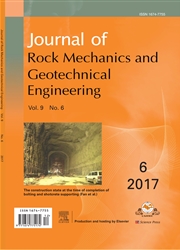

 中文摘要:
中文摘要:
Limit equilibrium method(LEM) and strength reduction method(SRM) are the most widely used methods for slope stability analysis. However, it can be noted that they both have some limitations in practical application. In the LEM, the constitutive model cannot be considered and many assumptions are needed between slices of soil/rock. The SRM requires iterative calculations and does not give the slip surface directly. A method for slope stability analysis based on the graph theory is recently developed to directly calculate the minimum safety factor and potential critical slip surface according to the stress results of numerical simulation. The method is based on current stress state and can overcome the disadvantages mentioned above in the two traditional methods. The influences of edge generation and mesh geometry on the position of slip surface and the safety factor of slope are studied, in which a new method for edge generation is proposed, and reasonable mesh size is suggested. The results of benchmark examples and a rock slope show good accuracy and efficiency of the presented method.更多还原
 英文摘要:
英文摘要:
Limit equilibrium method (LEM) and strength reduction method (SRM) are the most widely used methods for slope stability analysis. However, it can be noted that they both have some limitations in practical application. In the LEM, the constitutive model cannot be considered and many assumptions are needed between slices of soil/rock. The SRM requires iterative calculations and does not give the slip surface directly. A method for slope stability analysis based on the graph theory is recently developed to directly calculate the minimum safety factor and potential critical slip surface according to the stress results of numerical simulation. The method is based on current stress state and can overcome the disadvantages mentioned above in the two traditional methods. The influences of edge generation and mesh geometry on the position of slip surface and the safety factor of slope are studied, in which a new method for edge generation is proposed, and reasonable mesh size is suggested. The results of benchmark examples and a rock slope show good accuracy and efficiency of the presented method.
 同期刊论文项目
同期刊论文项目
 同项目期刊论文
同项目期刊论文
 期刊信息
期刊信息
